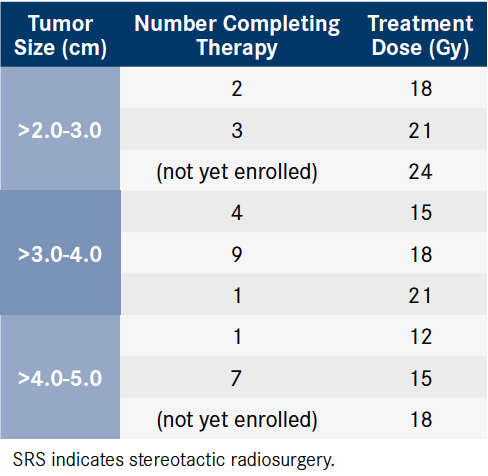Neoadjuvant Radiosurgery Shows Efficacy for Large Brain Metastases
Neoadjuvant stereotactic radiosurgery has gained interest. This approach allows for easier target delineation; a smaller margin of normal brain parenchymal receiving the radiosurgery dose, which may decrease toxicity; and the potential to reduce the risk of leptomeningeal disease by sterilizing the tumor margin preoperatively.
Sarah M. C. Sittenfeld, MD

Sarah M. C. Sittenfeld, MD
Radiation Oncology Resident,
Cleveland Clinic, Ohio
Erin S. Murphy, MD

Erin S. Murphy, MD
Radiation Oncologist,
Cleveland Clinic
Although stereotactic radiosurgery (SRS) is an effective treatment for brain metastases, single-session SRS alone for tumors larger than 2 cm provides local control of only 50%.1 Given the less-than-ideal outcomes with this strategy, surgical resection is an important part of the treatment regimen for large brain metastases, with adjuvant radiation required for optimal control.
Whole-brain radiation is an effective strategy post operatively to minimize recurrence, although it can be associated with significant acute and late toxicity, including cognitive decline. Postoperative SRS is also an alternative; however, this can include higher rates of leptomeningeal disease, found in up to 24% of patients.2
Given these disadvantages, neoadjuvant SRS has gained interest. This approach allows for easier target delineation; a smaller margin of normal brain parenchymal receiving the radiosurgery dose, which may decrease toxicity; and the potential to reduce the risk of leptomeningeal disease by sterilizing the tumor margin preoperatively.
Previous studies have evaluated neoadjuvant SRS compared with postoperative SRS, and results have been promising. These studies have used a lower SRS dose than generally employed for brain metastases per the Radiation Therapy Oncology Group (RTOG) standard, with a mean dose of 14 Gy (range, 11.6-18.0 Gy). In a cohort of 47 patients, results demonstrated good tolerance with low toxicity, but for larger lesions (>3.4 cm), higher rates of local failure were observed.3
Dose Escalation
To try to improve local control for larger brain metastases, our team at Cleveland Clinic in Ohio is investigating doseescalation strategies, starting with RTOG standard doses for each tumor size and increasing to a maximum tolerated dose.
Our investigation is split into 2 phases. The first is to determine the maximum tolerated SRS dose in the preoperative setting. We started dosing at the recommended RTOG levels and then increased in 3-Gy increments, with 2 patients enrolled at each dose level and followed for acute toxicity outcomes for 3 to 4 months before subsequent dose escalation. We classified any grade 3 or 4 toxicity as dose limiting.
Table. Neoadjuvant SRS Dose Delivered (Click to Enlarge)

Preliminary Results
At the 2019 American Society for Radiation Oncology Annual Meeting in September, Cleveland Clinic investigators and colleagues presented findings for the first 27 patients enrolled on the trial. The preoperative SRS doses delivered to these patients are detailed in the Table. The mean and median follow-up times are 15.2 and 9.2 months, respectively. Treatment has been very well tolerated; among 26 patients evaluable for acute toxicity, 85% (n = 22) had no reported toxicity and 15% (n = 4) had fatigue or grade 1 or 2 headaches. The investigators have observed no dose-limiting toxicities thus far.4
Local control at 6 and 12 months was 94.7% and 72.3%, respectively, with just 2 patients experiencing local recurrence. Distant brain control at 6 and 12 months was 71.7% and 49.6%, respectively, and overall survival at 6 and 12 months was 81.5% and 54.9%, respectively, with 14 patients alive at the time of analysis.
Further Evaluation of Dose Escalation
This study remains open to accrual in the phase I portion, as the maximum neoadjuvant tolerated dose has yet to be reached. We will continue to follow patients for up to 3 years to evaluate for local recurrence, distant control, overall survival, and late toxicity, including rates of radiation necrosis.
Once the study reaches maximum tolerated dose for treatment, the phase II component will accrue patients for neoadjuvant SRS at the maximum tolerated dose. Based on current control rates, we are hoping to see continued excellent rates of local control with this dose-escalated neoadjuvant strategy.
Although our institutional study is small, once it is completed, we are hopeful that a large multicenter trial can replicate this strategy, with similar positive results demonstrating safety and improved efficacy over previously used approaches.
The second phase will attempt to determine the efficacy of local control for patients with lesions treated at the maximum tolerated dose who undergo subsequent resection within 2 weeks of neoadjuvant therapy. We are enrolling patients with 1 to 4 brain metastases with at least 1 metastasis greater than 2 cm and up to 5 cm in greatest dimension who were candidates for surgical resection.




